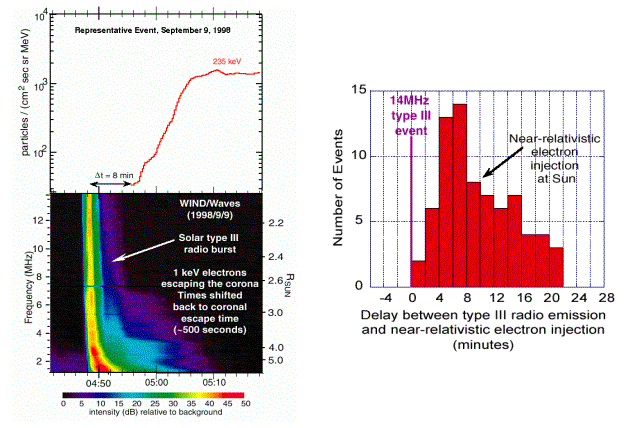
| ACE News Archives | ACE News #53 - June 20, 2001 |
ACE News Archives |

A study of impulsive, beam-like, 38-315 keV solar electron events measured by the EPAM instrument on ACE reveals that these near-relativistic (0.4c < v < 0.8c) particles are injected into the solar wind ~10 minutes after the associated solar electromagnetic emission from the chromosphere and low corona. In the example of an impulsive solar electron event shown in the left panel, the arrival of a 235 keV electron beam at ACE/EPAM is adjusted back to its coronal escape time, taking into account the 13.7 minute travel time along the interplanetary magnetic field. A Type-III radio burst measured by the Waves experiment on Wind is also adjusted back (by ~500 seconds). Such bursts are generated by a beam of >1 keV electrons moving out through the corona.
Our statistical analysis of 79 impulsive, beam-like, 38-315 keV solar electron events measured over the first three years of ACE/EPAM is shown in the right panel. Near-relativistic electrons were injected on average ~10 minutes after the >1 keV electrons that cause Type-III radio bursts so the sample event in the left panel may be considered as typical. The ACE/EPAM electrons are always injected later than the lower-energy electrons that generate the Type-III emission. Because most of the electron events came directly from active regions on the western hemisphere of the Sun, we conclude that the 10-minute delay results from vertical transport of the acceleration region in the corona. We note that a coronal shock (typical velocity ~1000 km/s) originating near the chromosphere and propagating radially upward takes 12 minutes to travel 1 solar radius. As the shock moves out, the electron acceleration process would tend to progressively higher energies with time, so that the near-relativistic electrons would begin to be released when the shock has traveled about another solar radius higher into the corona.
Contributed by Dennis Haggerty and Edmond Roelof of Johns Hopkins University/Applied Physics Laboratory. See The EPAM Homepage and The Waves Homepage for more on EPAM and Waves.
Last modified 20 June 2001, by
Andrew Davis